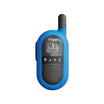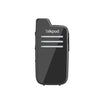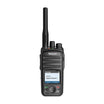Pretty neat! a great little radio easy to carry, pretty capable with features well beyond my skillset to learn. Please note my review is as a complete rookie, this is the first radio i have used outside of work units. Got primarily for backroads travel and hiking, but also to explore HAM radio to the limits i can as an unlicensed amateur. I've been using it for a few weeks now and here are my thoughts.
The A36Plus (A3P-M13B5UV3) came with 2 batteries, charger station, USB programming cable, antenna. Unit is listed as TX 462-467 MHz and RX 136-520 MHz for frequency range out of the box. Weight of unit, antenna and battery only 206g easy to carry or toss in a pack. I really like that the batteries are directly chargeable via USBC. Easy to setup, slap a battery on and you are setup for basic functionality. Out of the box you have pre-programmed GMRS channels, NOAA weather (receives Canada weather too) and commercial FM radio functions. For most users (self included) that is all you will need if for. Basic scanning is easy to use on the included or added channels including commercial FM radio.
What i can't test however is performance head to head with another radio or TX/RX from another radio as i don't have an additional unit. This was a note from another reviewer and is worth reading their take as well. This might be an issue of setup on the GMRS channels. It is a bit confusing to understand as a new user, but i think i got it setup properly and know how to adjust for other handhelds.
Reception is okay, I was hoping for more range but it is impressive when you do pickup local radio traffic from various sources. I don't know what the gain is on the antenna or how it compares but I am sure there are resources with the info. In my testing out on the trails in the woods it seemed like I was picking up reasonable coverage from sources, but we lack the repeater network in Canada for much help unless someone else is out there as far as I can tell in GMRS. Certainly more than enough range for chatter between 2 radios on the GMRS range however if that is your primary function.
Advanced users will like that it is dead simple to connect with Chirp for programming, the supplied cable might need a driver but the common CH340 USB chip's driver was installed for a previous Arduino or microcontroller board so i was good to go.
Note, the "official" Sofware is located on the talkpodonline website, which is a bit confusing as its different from their main page. Note: chirp looked for the A36 Plus 8W for communication the regular A36 plus profile did not work. There is also a vendor software package for programming, but chirp is far easier to use for me.
I also saw a video indicating that the manufacturer has open sourced the firmware and released it on github so that could prove quite beneficial in the future. At the time of review there was one project focused on the plus model but I didn't attempt to flash it over.
I just experimented with importing the open local channels from the included quick settings or repeaters DB that are all included in the app. Downloads from and uploads to the device are pretty fast. I do like that you can edit the settings from the software the menu on the device is a bit hard to navigate. I like that you can isolate comms on all the channels to RX only in the Chirp app.
A warning on the USB plug is not certified for use in Canada, and has no markings for our market, might want to leave that one in the box. However, the base station is fully UL certified for Canada and US
Overall as a newbie I am really happy with this little radio. Its way more compact than the old Motorola's we had at work, impressive feature set for a beginner like me and seemingly lots of room to grow if i go after a license or just enjoy listening in on the airwaves and trying to find signals out there in my area. There is a learning curve that is manageable with some research and videos to help.
The A36Plus (A3P-M13B5UV3) came with 2 batteries, charger station, USB programming cable, antenna. Unit is listed as TX 462-467 MHz and RX 136-520 MHz for frequency range out of the box. Weight of unit, antenna and battery only 206g easy to carry or toss in a pack. I really like that the batteries are directly chargeable via USBC. Easy to setup, slap a battery on and you are setup for basic functionality. Out of the box you have pre-programmed GMRS channels, NOAA weather (receives Canada weather too) and commercial FM radio functions. For most users (self included) that is all you will need if for. Basic scanning is easy to use on the included or added channels including commercial FM radio.
What i can't test however is performance head to head with another radio or TX/RX from another radio as i don't have an additional unit. This was a note from another reviewer and is worth reading their take as well. This might be an issue of setup on the GMRS channels. It is a bit confusing to understand as a new user, but i think i got it setup properly and know how to adjust for other handhelds.
Reception is okay, I was hoping for more range but it is impressive when you do pickup local radio traffic from various sources. I don't know what the gain is on the antenna or how it compares but I am sure there are resources with the info. In my testing out on the trails in the woods it seemed like I was picking up reasonable coverage from sources, but we lack the repeater network in Canada for much help unless someone else is out there as far as I can tell in GMRS. Certainly more than enough range for chatter between 2 radios on the GMRS range however if that is your primary function.
Advanced users will like that it is dead simple to connect with Chirp for programming, the supplied cable might need a driver but the common CH340 USB chip's driver was installed for a previous Arduino or microcontroller board so i was good to go.
Note, the "official" Sofware is located on the talkpodonline website, which is a bit confusing as its different from their main page. Note: chirp looked for the A36 Plus 8W for communication the regular A36 plus profile did not work. There is also a vendor software package for programming, but chirp is far easier to use for me.
I also saw a video indicating that the manufacturer has open sourced the firmware and released it on github so that could prove quite beneficial in the future. At the time of review there was one project focused on the plus model but I didn't attempt to flash it over.
I just experimented with importing the open local channels from the included quick settings or repeaters DB that are all included in the app. Downloads from and uploads to the device are pretty fast. I do like that you can edit the settings from the software the menu on the device is a bit hard to navigate. I like that you can isolate comms on all the channels to RX only in the Chirp app.
A warning on the USB plug is not certified for use in Canada, and has no markings for our market, might want to leave that one in the box. However, the base station is fully UL certified for Canada and US
Overall as a newbie I am really happy with this little radio. Its way more compact than the old Motorola's we had at work, impressive feature set for a beginner like me and seemingly lots of room to grow if i go after a license or just enjoy listening in on the airwaves and trying to find signals out there in my area. There is a learning curve that is manageable with some research and videos to help.











































Leave a comment
This site is protected by hCaptcha and the hCaptcha Privacy Policy and Terms of Service apply.